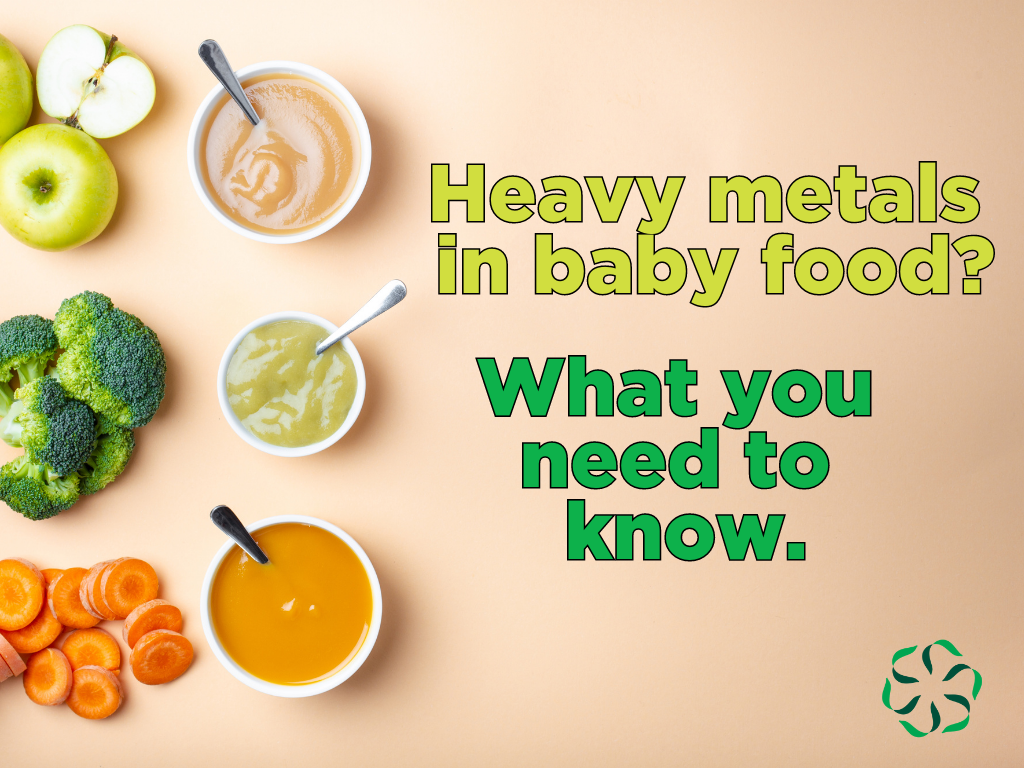We’ve seen the headlines; some baby foods contain heavy metals, but what does that mean? In this post, we break down the report to help keep you informed.
What are they finding in baby food?
A report presented to the U.S. House Oversight Committee states that some baby foods contain heavy metal ingredients at levels that warrant further investigation. The report highlights arsenic, lead, cadmium, and mercury.
The report compares the levels found in baby foods to the allowable limits set for heavy metals in drinking water and infant formula because there’s no established threshold for most heavy metals (arsenic being the exception) in baby food.
Why are there limits on heavy metals in formula and water but not on baby food?
For many infants, formula is their primary nutritional source. Formula-fed infants can consume 30 ounces of formula daily for a developmentally significant period (1).
We need water to live, and as adults we can consume up to 3 liters of water a day for the majority of our lives (1).
Formula and water represent a significant exposure from a single source over a sustained amount of time. Formula and water have stringent guidelines because the exposure is so great that the harm could be significant if left unchecked (1,2).
We suspect baby foods do not have a specifically established safety limit at this time because there isn’t the same intake/exposure as through formula and/or water.
How do heavy metals get into the foods?
Manufacturers do not add heavy metals to foods as an ingredient. Rather, heavy metals are found naturally in soil, air, and water where plants grow (1).
While the report focuses on arsenic, lead, cadmium, and mercury, other heavy metals found in soil can have adverse health impacts if consumed in sufficient quantities, such as zinc and copper (1,2). Additionally, there can be elevated amounts of heavy metals if the growing environment is near a mine or where there is certain industrial activity (1).
Certain fruits, vegetables, and grains can and do absorb heavy metals during their natural growing process. Even organically grown, non-GMO crops can contain these heavy metals (1,2).
The baby food brands listed in the report sell organic baby foods that contain these heavy metals. Heavy metal uptake can happen regardless of traditional or organic growing practices.
Why do crops absorb heavy metals?
Crops grow in soil, are exposed to air, and need water to thrive. Since soil, air, and water naturally contain heavy metals, the crops are exposed to heavy metals, and the metals are taken up by the crop during the growing process.
Some crops are more prone to absorbing specific metals than other plants. For example, rice naturally absorbs more arsenic, lettuce and onions accumulate lead more readily, spinach and carrots accumulate cadmium more easily (1,2).
It does not mean all fruits, vegetables, and grains are harmful, and we should avoid eating them. Quite the opposite as fruits and vegetables are an important and essential part of a healthy diet. Remember, the presence of a hazard does not necessarily mean there is a risk (1). Heavy metal can be present but at such a low level that it doesn’t cause harm.
Additionally, we typically consumed various fruits, vegetables, and grains grown in different areas, which helps limit our exposure to metals.
Is it possible to eliminate all heavy metals from baby foods?
Unless the fruits, vegetables, and grains are grown in wholly controlled environments (e.g., aeroponically, hydroponically, etc.), it’s impossible to eliminate the heavy metals. However, growers and manufacturers can, and do, mitigate risks.
Growers can (and often do) test the soil and water to see what heavy metals are present. Based on this information, they can plant crops that are not prone to absorbing the heavy metals present in those fields.
Manufacturers can (and often do) source fruits, vegetables, and grains for vulnerable populations, like babies and young children, from locations least impacted by the presence of heavy metals.
While these measures help reduce the heavy metals present in foods, it does not completely eliminate the presence of naturally occurring heavy metals from our diets.
Will the baby foods outlined in the report harm my child?
While we do not know a safe exposure level for the heavy metals found in baby foods, we know that a varied diet containing many different healthful fruits, vegetables, and grains can reduce repeated exposure to specific heavy metals.
It’s best to talk with a healthcare provider or a registered dietitian to get dietary advice specific for you and your family.
What are the next steps?
The U.S. Food and Drug Administration (FDA) currently monitors heavy metal exposure in foods and even issues recalls for contaminated products (1).
The FDA is also taking a risk-based approach to continue reducing our exposure to heavy metals and other environmental toxins.
The good news.
The holes in our current knowledge around heavy metal contamination in baby foods are clearly on display. We can now choose to fund research to help fill our knowledge gaps, inform responsible regulations, and further keep our children safe

